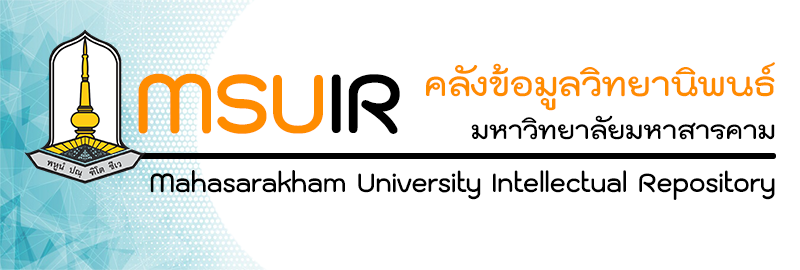Please use this identifier to cite or link to this item:
http://202.28.34.124/dspace/handle123456789/2804Full metadata record
| DC Field | Value | Language |
|---|---|---|
| dc.contributor | Kreangkrai Pongsri | en |
| dc.contributor | เกรียงไกร ป้องศรี | th |
| dc.contributor.advisor | Thatchai Chittranun | en |
| dc.contributor.advisor | ธัชชัย จิตรนันท์ | th |
| dc.contributor.other | Mahasarakham University | en |
| dc.date.accessioned | 2025-05-07T11:40:03Z | - |
| dc.date.available | 2025-05-07T11:40:03Z | - |
| dc.date.created | 2024 | |
| dc.date.issued | 27/1/2024 | |
| dc.identifier.uri | http://202.28.34.124/dspace/handle123456789/2804 | - |
| dc.description.abstract | This research and development study aim to address the evolving landscape of education in the digital age, specifically focusing on learning management competence for secondary school teachers under the Office of the Basic Education Commission. The objectives of the study are outlined as follows: 1) to examine the components and indicators of learning management competence, 2) to assess the current status and desired conditions of learning management competence, 3) to develop supplementary programs to enhance competence, and 4) to evaluate the outcomes of implementing these programs. The study comprises four phases, beginning with an assessment of the appropriateness of components and indicators through consultation with a group of 8 qualified individuals. The population involved active secondary school teachers under the Office of Basic Education Commission, with a sample size of 618 teachers selected through purposive sampling. Data collection tools encompassed assessments, questionnaires, and group discussion recording forms. Statistical analysis incorporated measures such as mean, percentage, standard deviation, and the alpha coefficient of Conbrako's Modified Priority Needs Index (PNI modified) technique. The key findings of the research are as follows: 1. Components and Indicators: The identified components of learning management competence in the digital age for secondary school teachers include Knowledge and Understanding, Process Techniques, Problem-Solving Skills, and Adaptation to Change. Validation by qualified individuals indicates that each component is deemed suitable. 2. Current Status of Digital Learning Management Competence for Secondary School Teachers: The current state of learning management competence in the digital age for secondary school teachers is overall at a high level, ranked from high to low as follows: problem-solving skills, process techniques, adaptation to change, and knowledge and understanding. The desired conditions for these competencies are at the highest level, with knowledge and understanding, process techniques, adaptation to change, and problem-solving skills being the most desired. 3. Program Development: The program development process involves three steps: Preparing for Development, Intensive Program Development, and Monitoring and Reflecting on Development Results. The designed program consists of six components, including Program Principles, Objectives, Goals, Development Activity Content, Development Process, and Evaluation. Evaluation results suggest the program's appropriateness, user manual, and activity set are highly likely to be suitable, appropriate, and beneficial at the highest level. 4. Program Implementation Results: The study of the results of implementing the program found that 1) Evaluation results of the program, program usage manual, and activity set by two evaluation groups were overall at a high level. 2) Satisfaction evaluation results regarding the program found that it is at the highest level. | en |
| dc.description.abstract | การวิจัยในครั้งนี้เป็นการวิจัยและพัฒนามีความมุ่งหมายดังนี้ 1) เพื่อศึกษาองค์ประกอบและตัวชี้วัดสมรรถนะการจัดการเรียนรู้ในยุคดิจิทัลสำหรับครูมัธยมศึกษา สังกัดสำนักงานคณะกรรมการการศึกษาขั้นพื้นฐาน 2) เพื่อศึกษาสภาพปัจจุบัน สภาพที่พึงประสงค์ สมรรถนะการจัดการเรียนรู้ในยุคดิจิทัลสำหรับครูมัธยมศึกษา สังกัดสำนักงานคณะกรรมการการศึกษาขั้นพื้นฐาน 3) เพื่อพัฒนาโปรแกรมเสริมสร้างสมรรถนะการจัดการเรียนรู้ในยุคดิจิทัลสำหรับครูมัธยมศึกษา สังกัดสำนักงานคณะกรรมการการศึกษาขั้นพื้นฐาน 4) เพื่อศึกษาผลการใช้โปรแกรมเสริมสร้างสมรรถนะการจัดการเรียนรู้ในยุคดิจิทัลสำหรับครูมัธยมศึกษา สังกัดสำนักงานคณะกรรมการการศึกษาขั้นพื้นฐาน โดยแบ่งระยะการวิจัยเป็น 4 ระยะ กลุ่มผู้ให้ข้อมูลเพื่อยืนยันความเหมาะสมขององค์ประกอบและตัวชี้วัดสมรรถนะการจัดการเรียนรู้ในยุคดิจิทัล ได้แก่ ผู้ทรงคุณวุฒิ จำนวน 8 คน ประชากร ได้แก่ ครู ที่ปฏิบัติการสอนในโรงเรียนมัธยมศึกษา สังกัดสำนักงานคณะกรรมการการศึกษาขั้นพื้นฐาน กลุ่มตัวอย่างที่ใช้ในการเก็บรวบรวมข้อมูล ได้แก่ ครู ที่ปฏิบัติการสอนในโรงเรียนมัธยมศึกษา สังกัดสำนักงานคณะกรรมการการศึกษาขั้นพื้นฐาน จำนวน 618 คน ได้มาโดยวิธีการสุ่มตัวอย่างโดย ใช้เทคนิคการสุ่มแบบหลายขั้นตอน (Multi-stage Random Sampling Technique) กลุ่มตัวอย่างที่นำโปรแกรมไปใช้ ได้แก่ ครู ที่ปฏิบัติการสอนในสังกัดสำนักงานเขตพื้นที่การศึกษามัธยมศึกษาร้อยเอ็ด จำนวน 8 คน ได้มาโดยใช้วิธีการเลือกแบบเจาะจง (Purposive Sampling) โดยเป็นผู้ที่สมัครใจเข้าร่วมพัฒนา เครื่องมือที่ใช้ในการเก็บรวบรวมข้อมูล ได้แก่ แบบประเมิน แบบสอบถาม และแบบบันทึกการอภิปรายกลุ่ม สถิติที่ใช้ในการวิเคราะห์ข้อมูล คือ ค่าเฉลี่ย ร้อยละ ส่วนเบี่ยงเบน มาตรฐาน สัมประสิทธิ์แอลฟาของคอนบราค เทคนิค Modified Priority Needs Index (PNImodified) ผลการวิจัยพบว่า 1. องค์ประกอบและตัวชี้วัดสมรรถนะการจัดการเรียนรู้ในยุคดิจิทัลสำหรับครูมัธยมศึกษา มี 4 องค์ประกอบ 17 ตัวชี้วัด ได้แก่ 1) ความรู้ความเข้าใจ 2) เทคนิคกระบวนการ 3) ทักษะการแก้ปัญหา 4) การปรับตัวสู่การเปลี่ยนแปลง ผลการยืนยันความเหมาะสมขององค์ประกอบและตัวชี้วัด โดยผู้ทรงคุณวุฒิพบว่า มีความ เหมาะสมทุกองค์ประกอบ 2. สภาพปัจจุบันสมรรถนะการจัดการเรียนรู้ในยุคดิจิทัลสำหรับครูมัธยมศึกษา โดยรวมอยู่ในระดับมาก เรียงลำดับจากมากไปน้อย ได้แก่ ทักษะการแก้ปัญหา เทคนิคกระบวนการ การปรับตัวสู่การเปลี่ยนแปลง ความรู้ความเข้าใจ สภาพที่พึงประสงค์ของสมรรถนะการจัดการเรียนรู้ในยุคดิจิทัลสำหรับครูมัธยมศึกษา โดยรวมอยู่ในระดับมากที่สุด เรียงลำดับจากมากไปน้อย ได้แก่ ความรู้ความเข้าใจ เทคนิคกระบวนการ การปรับตัวสู่การเปลี่ยนแปลง ทักษะการแก้ปัญหา 3. ผลการพัฒนาโปรแกรม ประกอบด้วย 3 ขั้นตอน ได้แก่ ขั้นตอนที่ 1 การเตรียมความพร้อมก่อนเข้ารับการพัฒนา ขั้นตอนที่ 2 การพัฒนาแบบเข้มตามโปรแกรม ขั้นตอนที่ 3 การติดตามผลหลังการพัฒนาและสะท้อนผล การออกแบบโปรแกรม พบว่า มีองค์ประกอบ ทั้งหมด 6 ด้าน คือ 1) หลักการของโปรแกรม 2) วัตถุประสงค์ของโปรแกรม 3) เป้าหมายของโปรแกรม 4) เนื้อหากิจกรรมการพัฒนาของโปรแกรม 5) กระบวนการพัฒนาของโปรแกรม และ 6) การประเมินผล ผลการประเมินความเหมาะสมของโปรแกรม คู่มือการใช้โปรแกรม และชุดกิจกรรม โดยผู้ทรงคุณวุฒิพบว่า มีความเป็นไปได้ ความเหมาะสม ความเป็นประโยชน์อยู่ในระดับมากที่สุด 4. การศึกษาผลการนำโปรแกรมไปใช้พบว่า 1) ผลการประเมินโปรแกรม คู่มือการใช้โปรแกรม และชุดกิจกรรม โดยกลุ่มผู้ประเมิน 2 กลุ่ม พบว่า โดยรวมทุกระดับมีความเป็นไปได้ ความเหมาะสม ความเป็นประโยชน์อยู่ในระดับมาก 2) ผลการประเมินความพึงพอใจต่อโปรแกรม พบว่าอยู่ในระดับมากที่สุด | th |
| dc.language.iso | th | |
| dc.publisher | Mahasarakham University | |
| dc.rights | Mahasarakham University | |
| dc.subject | โปรแกรม | th |
| dc.subject | สมรรถนะการจัดการเรียนรู้ | th |
| dc.subject | การจัดการเรียนรู้ในยุคดิจิทัล | th |
| dc.subject | Program | en |
| dc.subject | Learning Management Competency | en |
| dc.subject | Learning Management in The Digital Age | en |
| dc.subject.classification | Social Sciences | en |
| dc.subject.classification | Education | en |
| dc.subject.classification | Education science | en |
| dc.title | Competency Enhancement Program for Learning Management in the Digital Age for Secondary School Teachers under the Office of the Basic Education Commission | en |
| dc.title | โปรแกรมเสริมสร้างสมรรถนะการจัดการเรียนรู้ในยุคดิจิทัล สำหรับครูมัธยมศึกษา สังกัดสำนักงานคณะกรรมการ การศึกษาขั้นพื้นฐาน | th |
| dc.type | Thesis | en |
| dc.type | วิทยานิพนธ์ | th |
| dc.contributor.coadvisor | Thatchai Chittranun | en |
| dc.contributor.coadvisor | ธัชชัย จิตรนันท์ | th |
| dc.contributor.emailadvisor | thatchai.c@msu.ac.th | |
| dc.contributor.emailcoadvisor | thatchai.c@msu.ac.th | |
| dc.description.degreename | Doctor of Education (Ed.D.) | en |
| dc.description.degreename | การศึกษาดุษฎีบัณฑิต (กศ.ด.) | th |
| dc.description.degreelevel | Doctoral Degree | en |
| dc.description.degreelevel | ปริญญาเอก | th |
| dc.description.degreediscipline | Educational Administration | en |
| dc.description.degreediscipline | ภาควิชาการบริหารการศึกษา | th |
| Appears in Collections: | The Faculty of Education | |
Files in This Item:
| File | Description | Size | Format | |
|---|---|---|---|---|
| 64010561002.pdf | 8.27 MB | Adobe PDF | View/Open |
Items in DSpace are protected by copyright, with all rights reserved, unless otherwise indicated.

